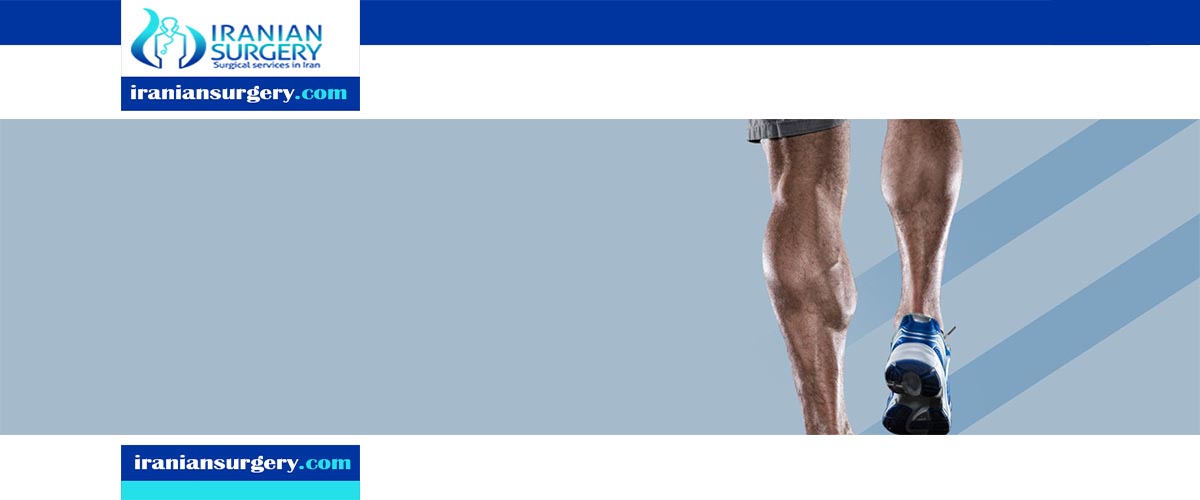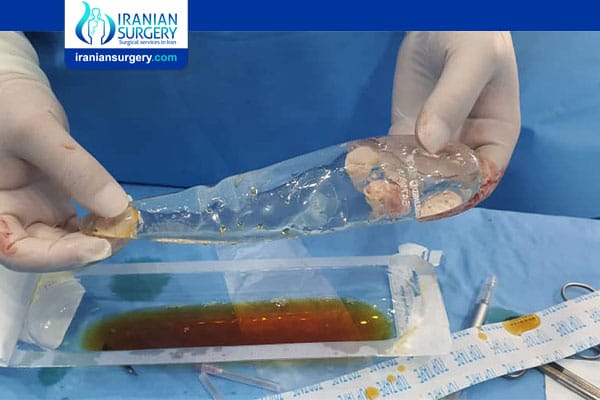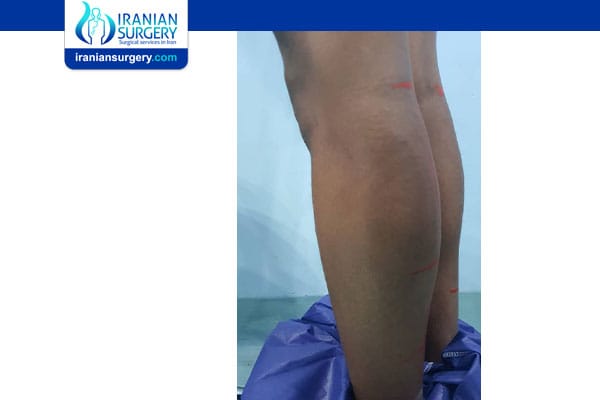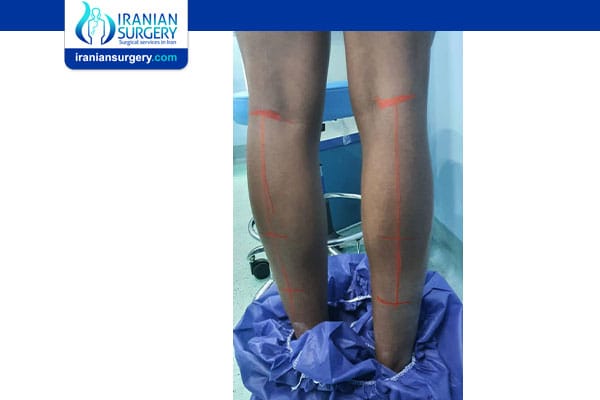Calf Implants in Iran
What are Calf Implants?
Calf Implants also known as calf augmentation, calf enlargement and calf enhancement. Calf augmentation with implants is a procedure to increase the size and improve the shape of the calf. Patients seek calf implants to tone and define the lower leg if it cannot be achieved with exercise alone, or to correct a muscle imbalance resulting from physical or birth defects. Both men and women are known to get calf implants.
Read more about : Knee replacemant surgery
Read more about : Miracle of Iranian surgeons with successful Leg lengthening surgery
Before Calf Implants
When to consider Calf Implants
. If you seek to emphasize the bulk of the calf muscle (usually men)
. If you desire a lower leg more anatomically proportionate to your thigh (usually women).
. If you are a bodybuilder and you’ve reached the plateau of calf development with exercise, but you’re not satisfied with the definition of your lower leg.
. If you wish to correct lower leg defects resulting from injury; disease, such as polio; or from birth conditions, such as clubfoot or spina bifida.
Advantages and Disadvantages
Pros:
. Enhances and reshapes the calf as desired, generally in a single procedure
. Fast and easy to perform, provided the proper steps are followed
. Adds both mass and definition in the bodybuilder seeking further muscle development.
Cons:
. Patients experience swelling and discomfort of the lower leg in the immediate post-operative period, with slight bruising around the incisions.
. Recovery to full physical activity generally takes 4 to 6 weeks
. Final result can take a few months after surgery to appreciate
These are the top three pros and cons to weigh when considering calf implants. If you want to focus on those specifically unique to you, please consult with your aesthetic plastic surgeon.
Read more about : Liposuction in Iran
Read more about : Rhinoplasty in Iran
Risks and Complications
Fortunately, significant complications from calf implants are infrequent. Your specific risks for calf augmentation will be discussed during your consultation.
All surgical procedures have some degree of risk. Some of the potential complications of all surgeries are:
. Adverse reaction to anesthesia
. Hematoma or seroma (an accumulation of blood under the skin that may require removal).
. Infection and bleeding
. Changes in sensation
. Scarring
. Allergic reactions
. Damage to underlying structures
. Unsatisfactory results that may necessitate additional procedures
Other risks specific to calf implants are outlined below:
. Visible implant due to incorrect pocket dissection or incorrect implant placement
. Nerve and/or muscle damage
. Slippage
. Asymmetry
You can help minimize certain risks by following the advice and instructions of your board-certified plastic surgeon, both before and after your calf implant surgery.
Preparing for Your Procedure
How do I prepare for a calf implants procedure?
Your surgeon will provide thorough preoperative instructions, answer any questions you may have, take a detailed medical history, and perform a physical exam to determine your fitness for surgery.
In advance of your procedure, your surgeon will ask you to:
. Stop smoking before undergoing surgery to promote better healing
. Avoid taking aspirin, certain anti-inflammatory drugs, and some herbal medications that can cause increased bleeding.
. Regardless of the type of surgery to be performed, hydration is very important before and after surgery for safe recovery.
. Possibly have blood and urine tests, and a pregnancy test for women, to prepare for anesthesia.
Calf augmentation is usually performed on an outpatient basis. Be sure to arrange for someone to drive you home after surgery and to stay with you at least the first night following surgery.
During Calf Implants
What can I expect on the day of my calf implant surgery?
Your calf implant surgery may be performed in a hospital/clinic, free-standing ambulatory facility, or office-based surgical suite. Most calf implant procedures take at least 1 to 2 hours to complete but may take longer.
. Medications are administered for your comfort during the surgical procedure.
. General anesthesia is commonly used during your calf implant procedure, although local anesthesia or intravenous sedation may be desirable in some instances.
. For your safety during the surgery, various monitors will be used to check your heart, blood pressure, pulse, and the amount of oxygen circulating in your blood.
. Your surgeon will follow the surgical plan discussed with you before surgery.
. After your procedure is completed, you will be taken into a recovery area where you will continue to be closely monitored. You will have drainage tubes in place. After implant surgery, you will be placed in a surgical dressing that includes a support or compression garment over your legs.
You will probably be permitted to go home after a short observation period unless you and your plastic surgeon have made other plans for your immediate post-operative recovery.
How is a calf implants procedure performed?
. Your legs are measured during a preoperative office visit to determine the right implant size for your calves, and then the implants are ordered for surgery.
. The day of surgery, you are given general anesthesia or sedation anesthesia and placed in the prone position (lying face down) on the operating table.
. The incision is made at the back of the knee, through the skin and fascia (sheet of connective tissue) covering the gastrocnemius muscle.
. Once your surgeon locates the most salient nerve (tibial nerve), the procedure can proceed without much concern for encountering other nerves or arteries, because there aren’t many in this area.
. A snug pocket (large enough only for the implant) is made between this fascia and muscle, into which the implant will be inserted.
. The implant is inserted and the leg is examined before the incision is closed with sutures.
You are placed in the supine position (lying on the back facing up) and taken to recovery.
Read more about : Chin implant in Iran
What are my options?
. Types of Implant and Implant Material
Calf implants are available in silicone gel and solid silicone. Silicone-gel implants can cause capsular contracture (shrinking and tightening of the scar tissue around the implant causing pain, unnatural firmness, and distortion); however, this rarely occurs in calf implants. Solid silicone implants can leave a palpable edge (one that can be felt) if placed too close to the surface. Silicone-gel calf implants are available in symmetrical sizes, which are suited best for the general population, and anatomical (asymmetrical sizes), which are best used for bodybuilders who desire more dramatic volume than the average-build patient.
Your surgeon can custom-carve solid silicone implants before inserting. Depending on your individual need and desire, one or two implants may be inserted in each leg. Body fat is not an option for this procedure, as it’s better used for augmenting smaller areas of the body, and because it absorbs into the area in which it’s placed.
. Implant Placement
The implants can be placed either subfascially (just beneath the fascia) or submuscularly (within the muscle). Subfascial placement is used more frequently because the procedure is less invasive, less difficult, and leads to a faster, less painful recovery for the patient. However, subfascial placement can sometimes result in implant rotation and a palpable implant, and the post-operative appearance can be less than desired, because the calf shape is defined more by the implant and less by the muscle tissue. This can occur using either silicone-gel or solid silicone implants. Lastly, subfascial placement requires more attention to implant placement.
Submuscular placement is considered more difficult because your surgeon must dissect deeper into muscle tissue. You can also expect a few additional days of recovery and greater discomfort. However, the implant is more securely and accurately placed within the muscle and results in a better aesthetic outcome, including a more natural shape because the calf muscles cover the implant. Surgical complications such as vascular or nerve damage can be more easily controlled with submuscular placement.
What will my calf implants incisions and scars be like?
The incisions for calf enlargement are made in the natural creases behind the knee.
After Calf Implants
Aftercare and Recovery
Your surgeon will discuss how long it will be before you can return to your normal level of activity and work. After surgery, you and your caregiver will receive detailed instructions about your post-surgical care, including information about:
. Drains, if they have been placed
. Normal symptoms you will experience
. Potential signs of complication.
Immediately after your calf implant surgery
The incision sites will be slightly bruised and your lower legs will be swollen. Any post-operative pain or discomfort you experience will be managed with medication. These symptoms generally subside after a few days.
When the anesthesia wears off, you may have some pain. If the pain is extreme or long-lasting, contact your physician. You will also have some redness and swelling after the surgery. Contact your surgeon to find out if your pain, redness, and swelling is normal or a sign of a problem.
Recovery time frame after calf implants
It is vitally important that you follow all patient care instructions provided by your surgeon. This will include information about care of your drains if necessary, taking an antibiotic if prescribed and the level and type of activity that is safe. Your surgeon will also provide detailed instructions about the normal symptoms you will experience and any potential signs of complications. It is important to realize that the amount of time it takes for recovery varies greatly among individuals.
. The first two weeks
. The first day or two after surgery, you should be assisted when getting up to go to the bathroom and your legs should be elevated as often as possible to reduce swelling and discomfort.
. The second day after surgery your dressings can be removed and you are encouraged to walk around the house and begin taking brief daily showers.
. You can expect to walk stiffly for the first week or so, but you are encouraged to gradually walk greater distances.
. Week two to eight
. Normal walking starts to return during the second and third week after surgery.
. The skin starts to stretch and the bruising and “shiny” appearance of the skin starts to fade.
. Activities such as running, biking, weight-lifting should be avoided until one or two months after surgery, depending on your comfort level.
. Full return to normal activities usually occurs after four to six weeks.
How long will the results last?
Calf implant results are permanent.
Maintain a relationship with your aesthetic plastic surgeon
For safety, as well as the most beautiful and healthy outcome, it’s important to return to your plastic surgeon’s office for follow-up evaluation at prescribed times and whenever you notice any changes in your calf implants. Do not hesitate to contact your surgeon when you have any questions or concerns.
Calf Implant Surgeons
How can I find the best Calf implant surgeon in Iran?
Plastic surgeons in Iran can make your body more appealing.
It is important that you seek the assistance of experienced and skilled cosmetic surgeons in Iran who have provided a suitable condition for people with limited budgets to undergo calf implant in Iran easily. It is worth explaining that the quality provided by Iranian surgeons is far higher than other countries including Turkey and India.
Plastic surgeons in Iran, have performed numerous procedures annually which make them more experienced than other countries’ plastic surgeons, due to high demand and low cost of Calf implant in Iran, thousands of people travel to Iran every year to undergo Calf implant in Iran with the best cosmetic surgeons at an affordable and reasonable price.
10 common question about calf implant surgery
Are calf implants dangerous?: There is always a risk of infection or adverse reaction to anesthesia. Significant complications from calf implants are unusual, however. In rare cases, bleeding or implant shifting may occur. In extremely rare instances, the calf implants may weaken the nearby muscle.
Are calf implants worth it?: Both men and women are known to get calf implants. Overall, calf implants have both high rates of efficacy and low rates of side effects. But since all cosmetic surgeries can be risky (and costly), it’s important to learn all the ins and outs of calf implant procedures before booking your appointment.
How long does it take to recover from calf implants?: Most of my patients with one implant per leg can return to doing desk work within 2 weeks, while the vast majority have returned to normal ambulation after 2-4 weeks.” Recovery from calf enlargement also sometimes depends on the actual placement of the implants.
What are calf implants made from?: Body builders may want both the inner and outer lower leg filled out. Calf augmentation usually is performed by placing an implant made out of silicone rubber over the muscles, on the medial aspect of the calf.
Can you get thigh implants?: Cosmetic hip implants and thigh implants can be considered, depending on placement in the body, as being one and the same. They are flat, silicone slices that are placed under the skin and substructures that will provide, after healing, a more visible curvaceous outward appearance in the pelvic and lower pelvic areas.
How soon can a calf walk?: How to Get a Newborn Calf to Stand. Most calves will stand by themselves within the first 30 minutes following birth, although some calves take up to two hours.
Can I get fat injected into my legs?: How fat injections are administered. Fat injection requires a more extensive procedure than “off-the-shelf” soft tissue fillers. A “donor area” must be determined (such as the abdomen or buttocks) and liposuction is used to extract the fat. The suctioned fat can then be transferred to the face, as a graft.
How can I get fat legs?: Choose exercises that help to tone your leg muscles, and you’ll look and feel healthier by your first beach day.
…
Read on for three ways to reduce your leg fat and tone your legs.
Do aerobic exercise. The first step to burning overall body fat is aerobic exercise. …
Strengthen muscles. …
Reduce calories.
Do cows miss their calves?: This study shows that calves which have contact to their mothers or to other cows during rearing become more sociable adults. Calves of dairy cows are generally separated from their mothers within the first 24 hours after birth. The majority of the milk thus enters the food market and not the stomachs of the calves.
How do I know if my calf has nursed?: A calf that is shivering and has not nursed may be a candidate for being moved to shelter or even a warming device. This is especially true if the calf is lethargic or has difficulty raising its head. A good test to help you determine if a newborn calf needs shelter is to place your finger in its mouth.




